flat tire AUDI S7 2013 Owners Manual
[x] Cancel search | Manufacturer: AUDI, Model Year: 2013, Model line: S7, Model: AUDI S7 2013Pages: 310, PDF Size: 77.45 MB
Page 64 of 310
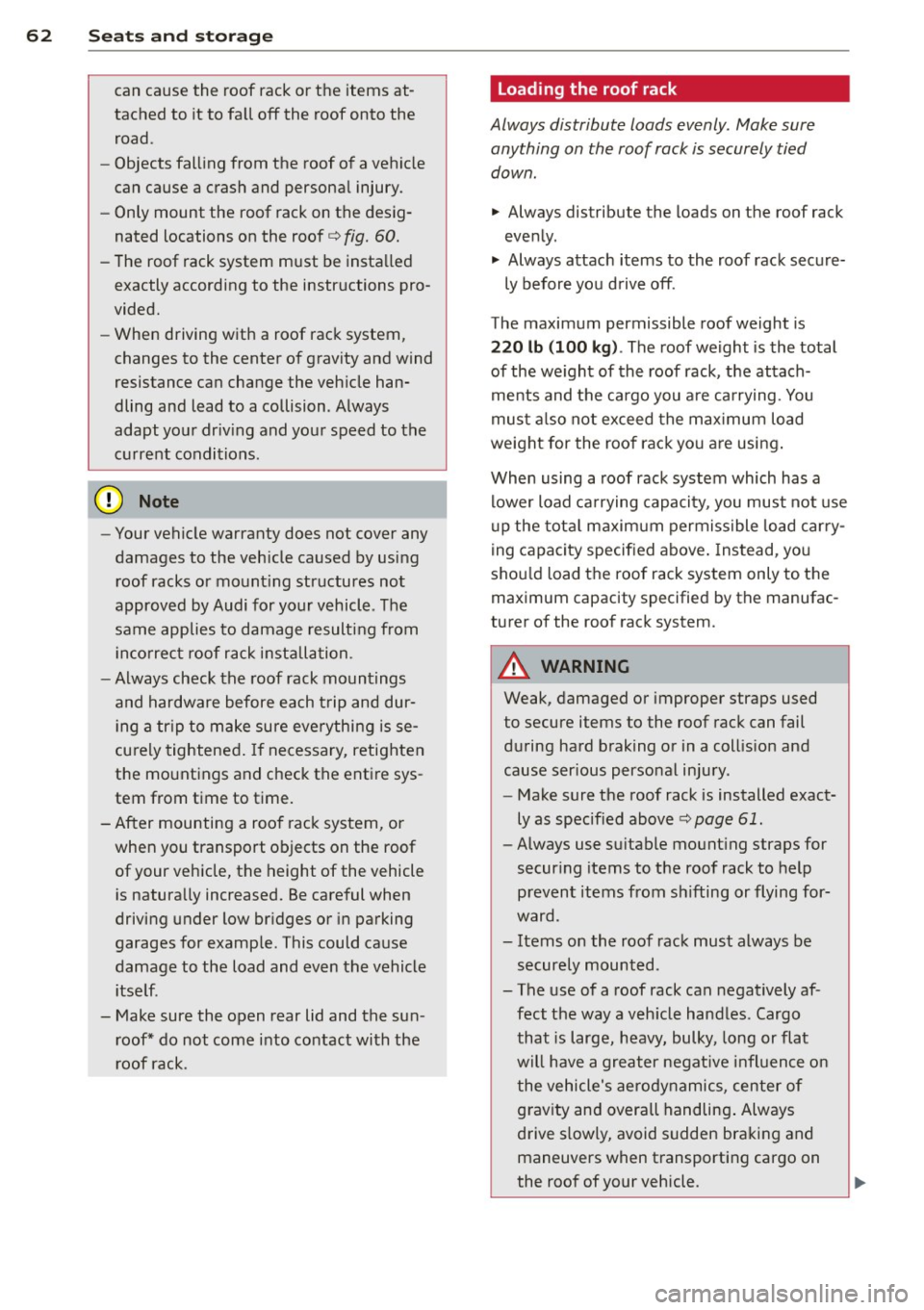
62 Seat s a nd s tor ag e
can cause the roof rack or the items at
tached to it to fall off the roof onto the road .
- Objects falling from the roof of a vehicle
can cause a crash and personal injury .
- Only mount the roof rack on the desig
nated locations on the roof
c> fig. 60.
-The roof rack system must be insta lled
exactly according to the instructions pro
vided.
- When driving with a roof rack system,
changes to the center of gravity and wind
resistance can change the veh icle han
dling and lead to a collision . Always
adapt your driv ing and your speed to the
cu rrent conditions .
@ Note
-Your vehicle warranty does not cover any
damages to the veh icle caused by using
r oof racks or mount ing structures not
approved by Audi for your vehicle . The
same applies to damage resulti ng from
i n co rrec t roof rack installation .
- Always check the roof rack mountings
and hardware before each t rip and dur
i ng a tr ip to make sure eve rything is se
cu rely tightened . If necessary, retighten
the mo untings and check the entire sys
tem from time to time.
- After mounting a roof rack system, or when you transport objects on the roof
of your ve hicle, the height of the vehicle
i s natura lly increased. Be careful when
driving under low br idges or i n parking
garages for examp le . This could cause
damage to the load and even the vehicle i tse lf.
- Make sure the open rear lid and the sun
r oof* do not come into contact with the
r oof rack .
Loading the roof rack
Always distribute loads evenly. Make sure
anything on the roof rack is securely tied
down .
.. Always distribu te the loads on the roof rack
eve nly .
.. Always attach items to the roof rack sec ure-
ly before yo u drive off.
The maximum permissible roof weight is
2 20 lb (100 kg ). The roof we ight is the total
of the we ight of the roof rack, t he attach
ments and the cargo you a re ca rrying. You
must also not exceed the max imum load
weight for the roof rack yo u are using .
When using a roof rack system which has a lower load ca rrying capaci ty, you must not use
u p the tot al maxim um permiss ible load car ry
ing capacity specif ied above . Ins tead, you
sho uld load the roof rack system only to the
maximum capacity specified by the manufac
turer of the roof rack system .
A WARNING
-Weak, damaged or improper straps used
to secure items to the roof rack can fail
during hard braking or in a coll is io n and
cause ser ious personal inju ry .
- Make sure the roof rack is installed exact
ly
as specified above i:> page 61.
-Always use su itable mount ing straps for
secur ing items to the roof rack to help
p revent items from sh ifting or flying for
ward .
- Items on the roof rack must always be securely mounted .
- The use of a roof rack can negatively af
fect the way a veh icle hand les . Cargo
that is large, heavy, bulky, long or flat
will h ave a greater negat ive i nfl uence on
t he vehicle's aerodynamics, center of
grav ity and overall handling . Always
drive s lowly, avoid sudden braking and
maneuvers when t ransporting cargo on
the roof of your vehicle .
ll>-
Page 139 of 310
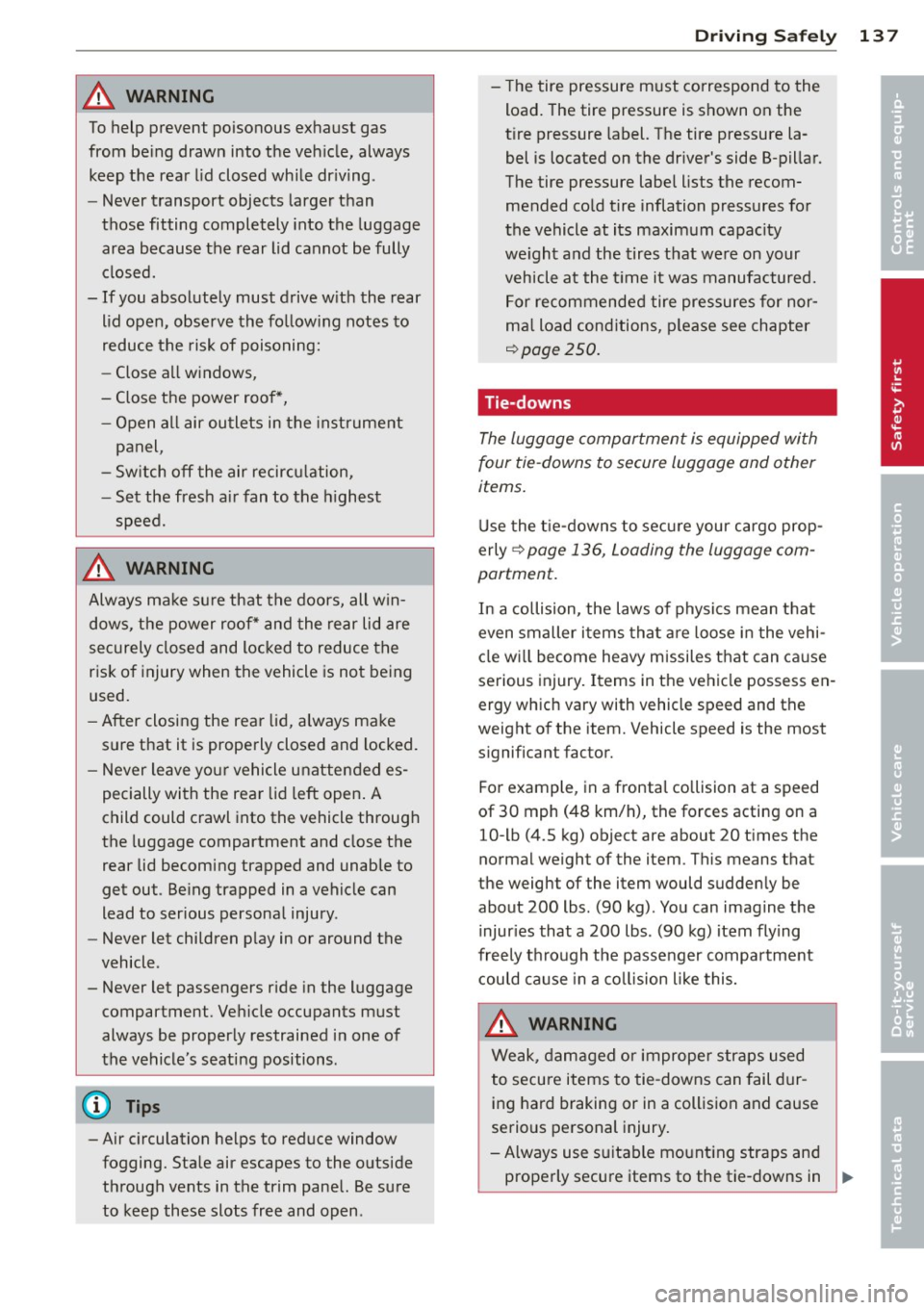
A WARNING ,~
To help prevent poisonous exhaust gas
from being drawn into the vehicle, always
keep the rear lid closed while driving .
- Never transport objects larger than
those fitting completely into the luggage
area because the rear lid cannot be fully
closed.
- If you absolutely must drive with the rear
lid open, observe the following notes to
reduce the risk of poisoning:
- Close all windows,
- Close the power roof*,
- Open all air outlets in the instrument
panel,
- Switch off the air recirculation,
- Set the fresh air fan to the highest
speed.
A WARNING
Always make sure that the doors, all win dows, the power roof* and the rear lid are
securely closed and locked to reduce the
risk of injury when the vehicle is not being
used.
- After closing the rear lid, always make
sure that it is properly closed and locked.
- Never leave your vehicle unattended es
pecially with the rear lid left open. A
child could crawl into the vehicle through
the luggage compartment and close the
rear lid becoming trapped and unable to
get out. Being trapped in a vehicle can
lead to serious personal injury.
- Never let children play in or around the
vehicle .
- Never let passengers ride in the luggage
compartment. Vehicle occupants must
always be properly restrained in one of
the vehicle's seating positions.
Gj) Tips
-Air circulation helps to reduce window fogging. Stale air escapes to the outside
through vents in the trim panel. Be sure
to keep these slots free and open .
-
Driving Safely 137
-The tire pressure must correspond to the
load. The tire pressure is shown on the
tire pressure label. The tire pressure la
bel is located on the driver's side B-pillar.
The tire pressure label lists the recom
mended cold tire inflation pressures for
the vehicle at its maximum capacity
weight and the tires that were on your
vehicle at the time it was manufactured. For recommended tire pressures for nor
mal load conditions, please see chapter
r:!)page250.
Tie-downs
The luggage compartment is equipped with
four tie-downs to secure luggage and other
items.
Use the tie-downs to secure your cargo prop
erly<>
page 136, Loading the luggage com
partment.
In a collision, the laws of physics mean that
even smaller items that are loose in the vehi
cle will become heavy missiles that can cause
serious injury. Items in the vehicle possess en
ergy which vary with vehicle speed and the
weight of the item. Vehicle speed is the most
significant factor.
For example , in a frontal collision at a speed
of 30 mph (48 km/h), the forces acting on a 10-lb (4.5 kg) object are about 20 times the
normal weight of the item. This means that
the weight of the item would suddenly be about 200 lbs. (90 kg) . You can imagine the
injuries that a 200 lbs . (90 kg) item flying
freely through the passenger compartment
could cause in a collision like this.
A WARNING
Weak, damaged or improper straps used
to secure items to tie-downs can fail dur
ing hard braking or in a collision and cause
serious personal injury.
-Always use suitable mounting straps and properly secure items to the tie-downs in
'
•
•
Page 168 of 310
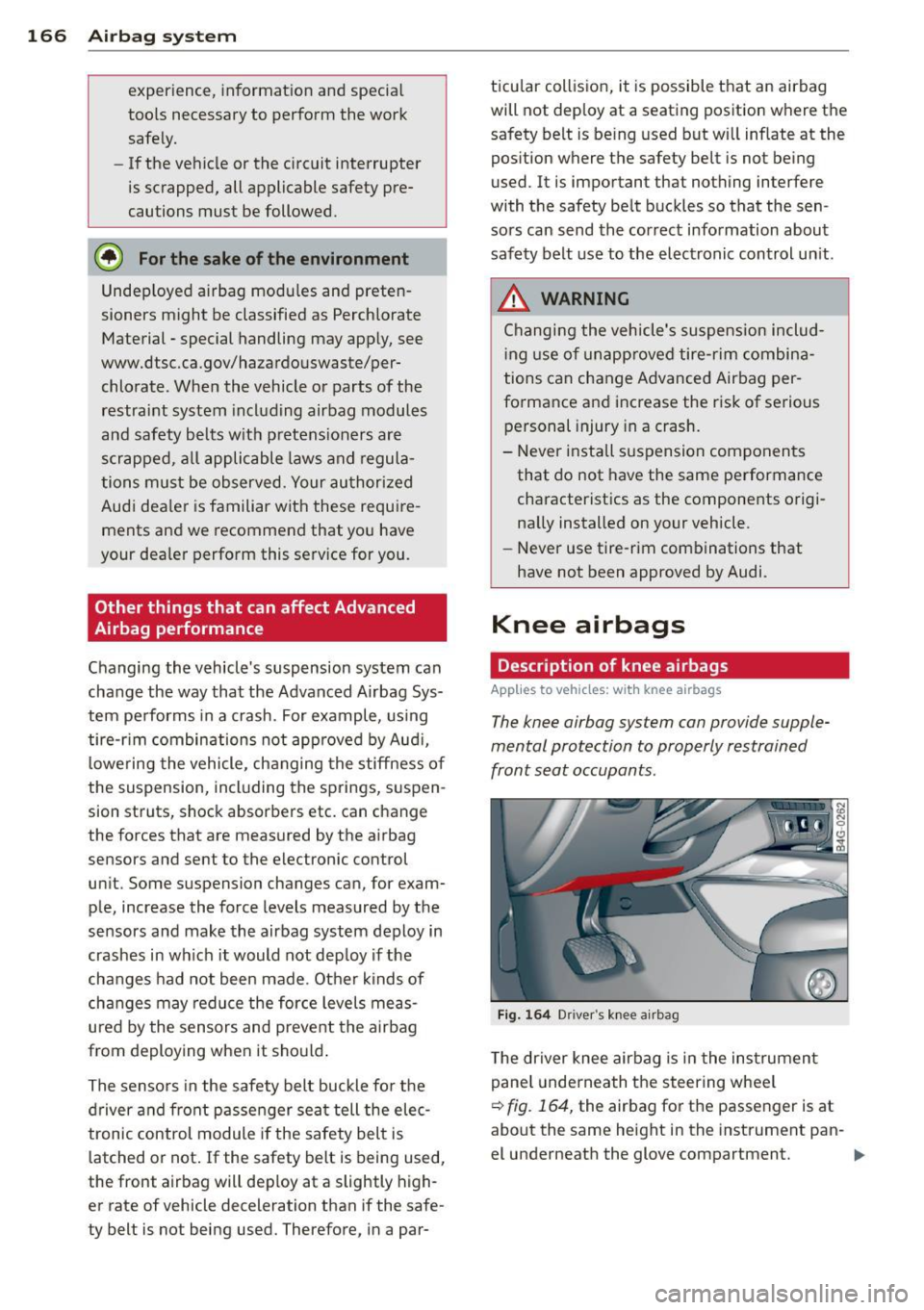
166 Airbag system
experience, informat ion and specia l
too ls necessary to perform the work
safely.
- If the vehicle or the c ircuit interrupter
is scrapped, all applicable safety pre
cautions must be followed.
@ For the sake of the environment
Undeployed a irbag modu les and preten
sioners might be classified as Perchlorate Material - special handling may apply, see
www.dtsc.ca.gov/haza rdo uswaste/per
chlorate. When the vehicle or parts of the
restraint system including airbag modules
and safety bel ts w it h pretens ioners are
s crapped, a ll applicable laws and regula
tions mus t be observed. Your au thori zed
Aud i dea le r i s familiar with these requ ire
ments an d we recommend that you have
your dea ler perfo rm this se rv ice for you.
Other things that can affect Advanced
Airbag performance
Changing the vehicle's suspension system can
change the way that the Advanced A irbag Sys
tem pe rforms in a crash. For example, us ing
tire-r im combina tions not app roved by Aud i,
lowe ring the vehicle, ch anging the stiffness o f
the suspension, incl uding the springs, s uspen
sion struts, shock absorbers etc. can change
the forces that are measured by the a irbag
sensors and sent to the electronic control
un it. Some suspension changes can, for exam
p le, increase the force levels measured by the
sensors a nd make the airbag system deploy in
crashes in w hich it would not dep loy if the
changes had not been made . Other kinds of
ch an ges may reduce the force levels meas
u re d by the sensors and prevent the airbag
from deploying when it sho uld .
The senso rs in the safety belt buckle fo r th e
d river a nd front p asse nger sea t tell the elec
tronic control module if the safety belt is
l atched or not .
If the safety belt is being used,
the front airbag will dep loy at a slightly high
er rate of vehicle deceleration than if the safe
ty belt is not being used. Therefore, in a par- t
icu lar collisio n, it is possible that an airbag
will not dep loy at a seat ing position where the
safety belt is be ing used b ut w ill inflate at the
pos ition where the safety belt is not be ing
used. It is important that nothing interfere
with t he safety be lt buckles so that the sen
sors can send the correct info rmation about
safety belt use to the electronic control un it .
_&. WARNING
Changi ng the vehicle's suspension includ
i ng use of unapp roved tire-rim combin a
tions can change Advanced Airbag per
formance an d increase the risk of serious
pe rsonal injury in a crash .
- Never install s uspension components
that do not have the same pe rformance
characteristics as the components o rigi
na lly installed on your vehicle.
- Never use tire-rim combinations that
have not been approved by Audi.
Knee airbags
Description of knee airbags
App lies to vehicles : wi th knee airbags
The knee airbag system can provide supple
mental protection to properly restrained
front seat occupants .
Fig. 1 64 Driver 's knee a irbag
T he dr iver knee airbag is in the ins trument
pane l underneath the steering wheel
~ fig. 164, the airbag for the passenger is at
about the same height in the instrument pan-
el underneat h the glove compartment. .,.
Page 212 of 310
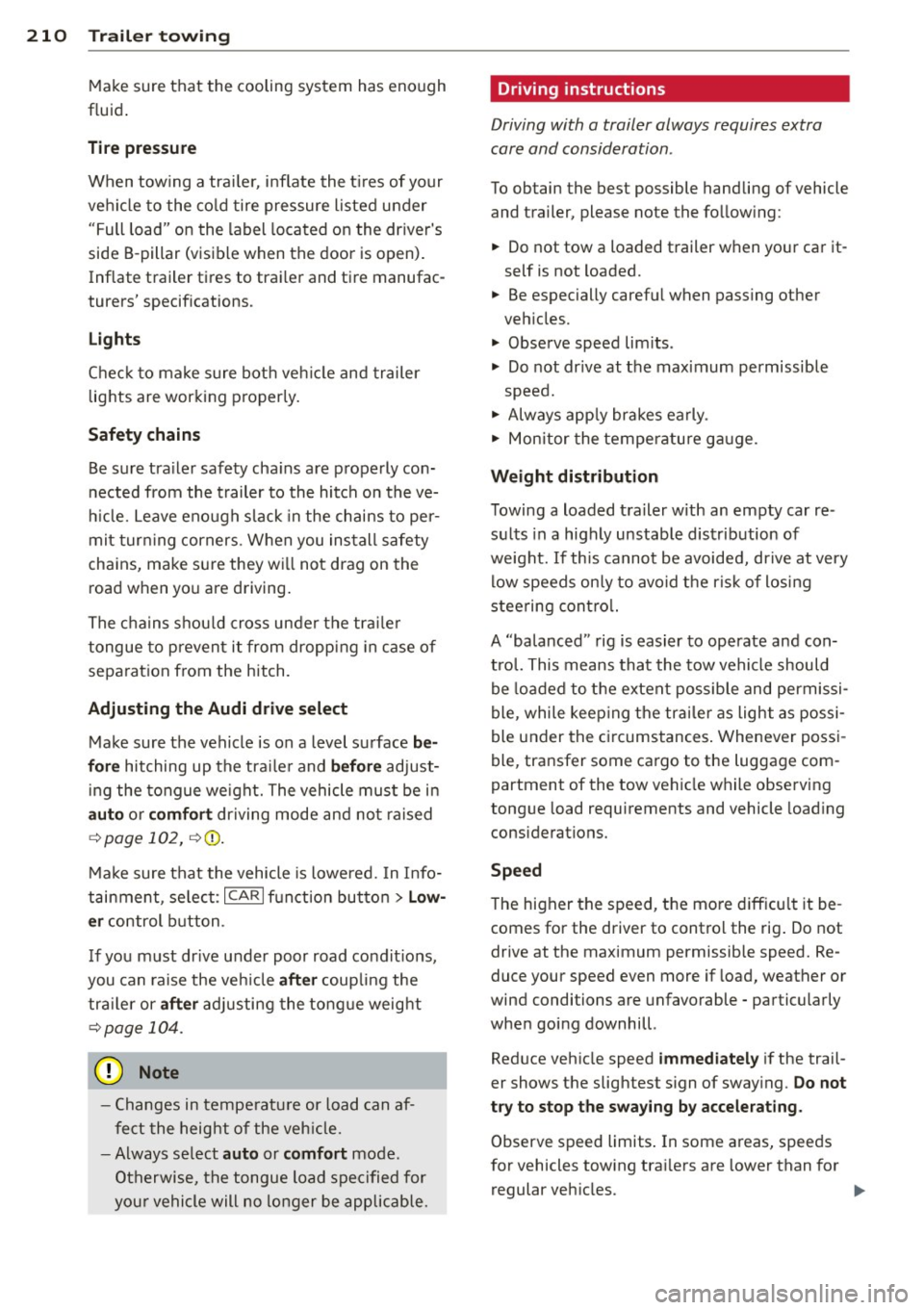
210 Trailer towing
Make sure that the cooling system has eno ugh
fluid .
Tire p res sure
When tow ing a trai le r, inflate the t ires of your
vehi cle to the co ld tire pressure listed under
"Full load" on the label located on the driver's
side B-pillar (visible when the door is open) .
Inflate trailer t ires to trai ler and tire manufac
turers' specifications.
Lights
Chec k to make s ure both veh icle and trailer
lights are working properly.
Safety chains
Be sure tra iler safety cha ins are properly con
nected from the trailer to the hitch on the ve
h icle. Leave enough slack in the chains to per
mit turn ing corners . When you install safety
cha ins, make su re they wi ll not drag on the
road when yo u are driving.
The chains shou ld cross under the tra iler
tongue to prevent it from dropping in case of
separation from the hitch.
Adjusting the Audi drive select
Make sure the vehicle is on a level su rface be
for e
hitching up the tra ile r and b efor e adjust
ing the tongue weight. The vehicle must be in
auto or comfort dr iving mode and no t raised
qpage 102, q(D _
Make sure that the vehicle is lowered. In Info
tainment , se lect:
ICARI f u nction button> Low
e r
control b utton .
I f you m ust dr ive under poor road co ndit ions,
you can raise the veh icle
aft er coup ling the
tra iler or
after adjusting the tong ue weig ht
q page 104.
-Changes in tempe ratu re or load can af
fect the heig ht of the veh icle.
- Always se lect
auto or comfort mode.
Otherwise, the tongue load spec ified for
your vehicle will no longer be applicable.
Driving instructions
Driving with a trailer always requires extra
care and consideration .
To obtain the best possible handling of vehicle
and trailer, please note the fo llow ing:
.,. Do not tow a loaded trailer when your car it
self is not loaded.
.,. Be especially carefu l when passing other
veh icles.
.,. Observe speed lim its .
.,. Do not dr ive at the maximum permissible
speed.
.,. Always app ly brakes early .
.,. Monitor the temperatu re ga uge.
Weight distribut ion
T owing a loaded trailer with an empty car re
su lts in a highly unstab le distribution of
we ight. If this cannot be avoided, drive at very
low speeds on ly to avoid t he risk of losing
steering con trol.
A "ba lanced " rig is easier to operate and con
tro l. This means that the tow vehicle should
be loaded to the exten t possible and permissi
ble, while keep ing the trai ler as light as possi
ble under the c ircumstances . Whenever poss i
ble, transfer some cargo to the luggage com
partment of the tow veh icle while observing
tong ue load requirements and vehicle load ing
considerations.
Speed
The higher the speed, the more difficu lt it be
comes for the driver to control the rig . Do not
drive at the maximum permissible speed. Re
duce your speed even more if load, weather or
wind conditions are unfavorable -particularly
whe n going downhill.
Red uce veh icle speed
immediately if the trail
er shows the slightest s ign of sway ing .
Do not
try to stop the swa ying b y accelerating .
Observe speed limits . In some a reas, speeds
for vehicles tow ing trai lers are lower than for
regular veh icles . .,.
Page 248 of 310
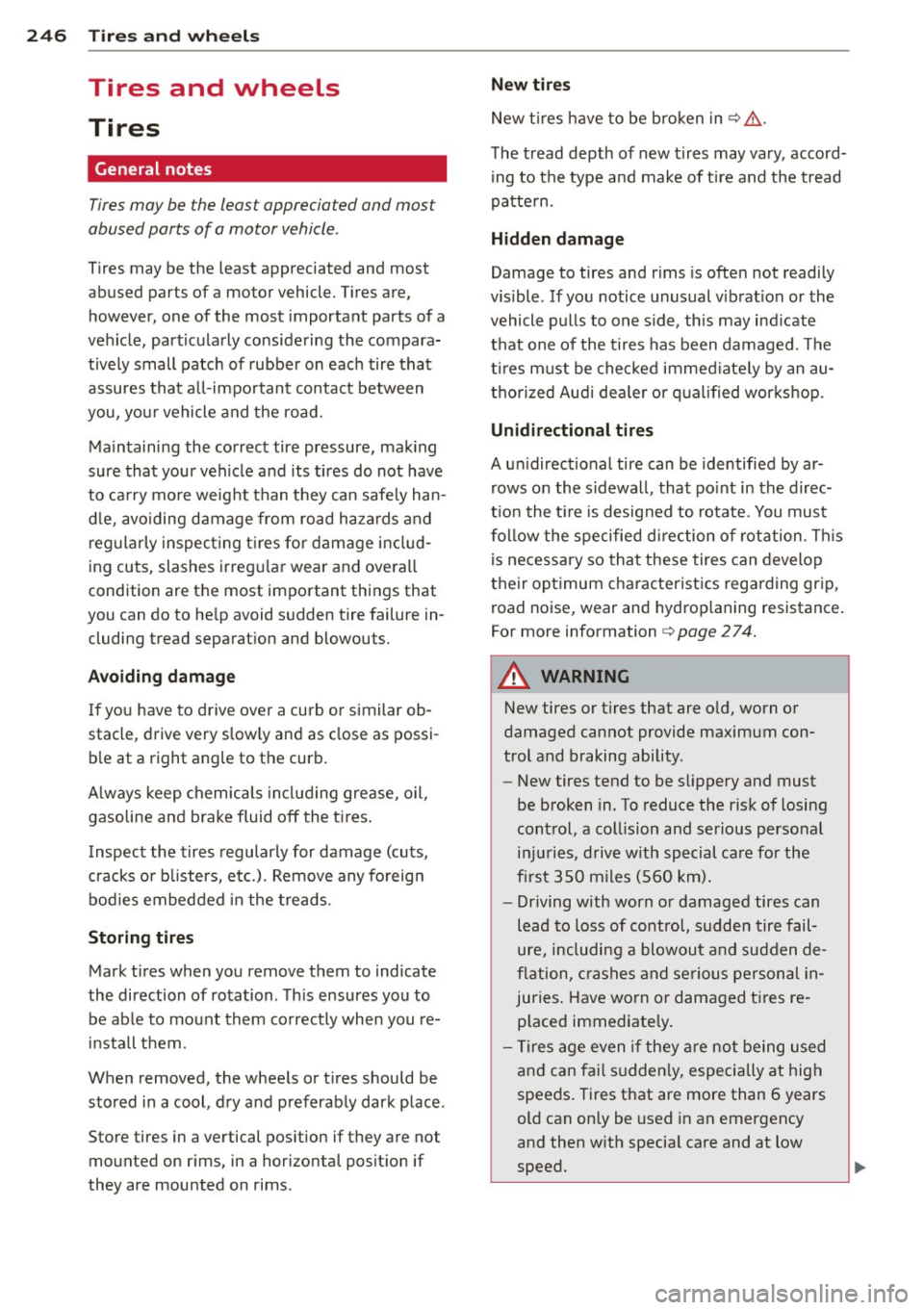
24 6 T ire s and whee ls
Tires and wheels
Tires
General notes
Tires may be the least appreciated and most
abused parts of a motor vehicle .
Tires may be the least appreciated and most
abused parts of a motor vehicle . Tires are,
however, one of the most important parts of a
vehicle, particularly considering the compara
tive ly small patch of rubber on each tire that
assures that all -important contact between
you, your vehicle and the road.
Maintaining the correct tire pressure, making
sure that your vehicle and its tires do not have
to carry more weight than they can safe ly han
d le, avoiding damage from road hazards and
reg ularly inspecting t ires for damage includ
ing cuts, slashes irregu la r wear and overall
condition are the most important things that
you can do to he lp avoid sudden tire failure in
cluding tread separation and blowouts.
A vo idin g dama ge
I f you have to drive over a curb or similar ob
stacle, drive very slow ly and as close as possi
ble at a right angle to the curb.
A lways keep chem icals including grease, oil,
gasoline and b rake fluid off the tires.
Inspect the tires regularly for damage (cuts,
cracks or bl isters, etc.). Remove any foreign
bod ies embedded in the treads.
St orin g tire s
Mark tires when you remove them to indicate
the direction of rotation . Th is ensures you to
be ab le to mount them correctly when you re
install them.
When removed, the wheels or tires should be
stored in a cool, dry and preferably dark place .
Store tires in a vertical position if they are not mounted on rims, in a horizontal position if
they are mounted on rims. N
ew tir es
New t ires have to be broken in¢&,. .
The tread depth of new t ires may vary, accord
ing to the type and make of t ire and the tread
pattern .
Hidden damag e
Damage to tires and r ims is often not readily
vis ible . If you notice unusual vibrat ion or the
vehicle pulls to one s ide, th is may ind icate
that one of the t ires has been damaged . T he
t ir es must be checked immed iate ly by an au
tho rized Aud i dea le r or q ualified wor kshop.
Unidirecti onal t ires
A un idirectional tire can be identified by ar
rows on the sidewall, that po int in the direc
t ion the t ire is designed to rotate. You must
fol low the specified direction of rotation . This
is necessary so that these tires can develop
their optimum characteristics regarding grip, road noise, wear and hydrop laning resistance.
For more information
¢ page 274.
A WARNING
-New tires or tires that are old, worn or
damaged cannot provide maximum con
trol and braking ability .
-
-New tires tend to be slippery and must
be broken in . To reduce the risk of losing
control, a collision and ser ious personal
injuries, drive w ith special ca re for the
fi rst 350 m iles (560 km).
- Driving with worn or damaged tires can lead to loss of control, sudden tire fail
ure, including a blowou t and sudden de
flation, c rashes and serious personal in
juries . Have worn or damaged tires re
p laced immediate ly .
- Tires age even if they are not being used
and can fai l sudden ly, especially at high
speeds. Tires that are more than 6 years
old can only be used in an emergency
and then w ith special care and at low
speed.
Page 249 of 310
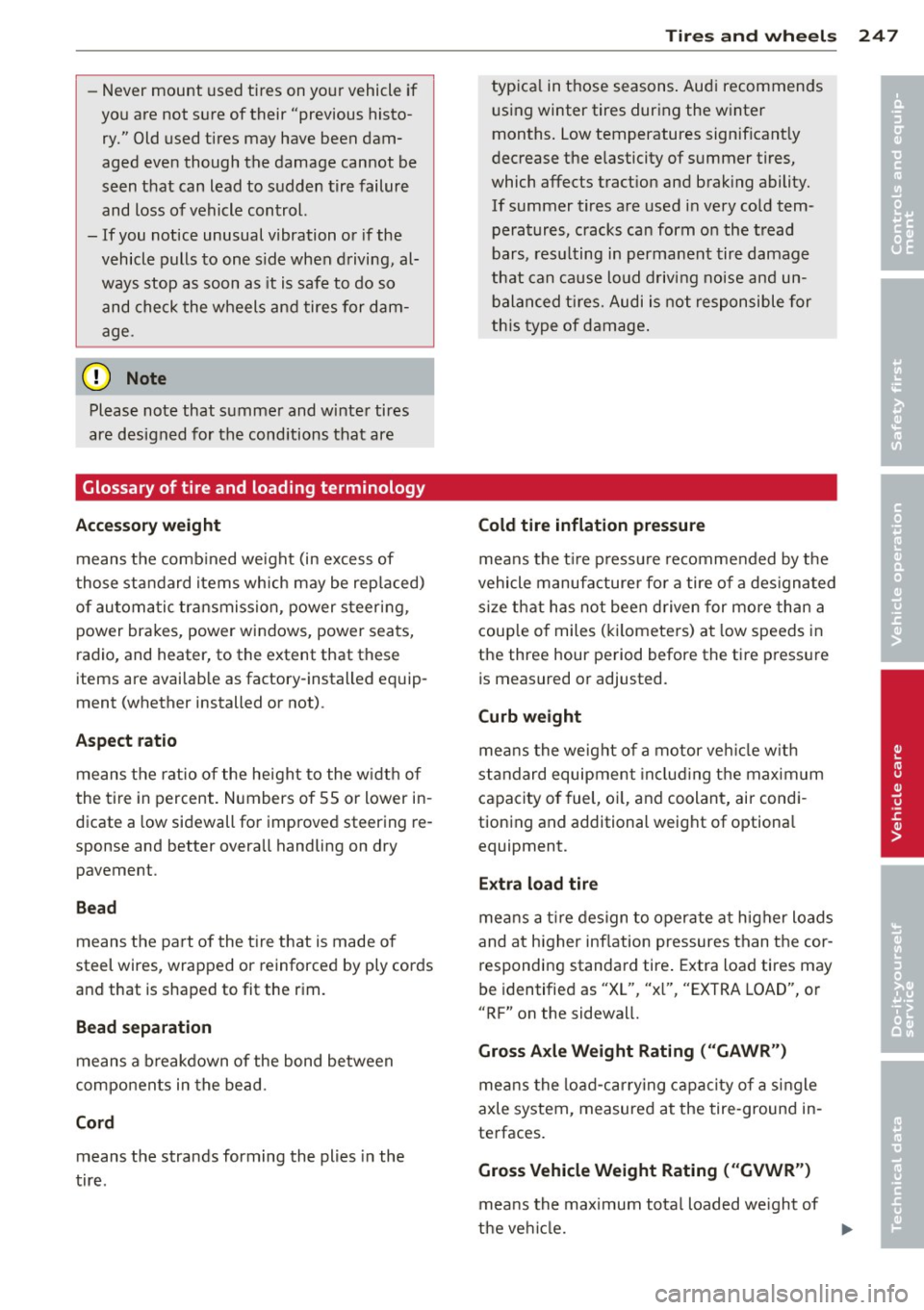
-Never mount used tires on yo ur vehicle if
yo u are not sure of their "previous histo
ry." Old used tires may have been dam
aged even though the damage cannot be
seen that can lead to sudden tire failure
and loss of vehicle control.
- If you notice unusual vibration or if the
vehicle pulls to one side when d riving, al
ways stop as soon as it is safe to do so
and check the wheels and tires for dam
age .
(D Note
Please note that summe r and wi nte r tires
are designed for the cond itions that are
Glossary of tire and loading terminology
Accessory weight means the comb ined weight (in excess of
those sta ndard items which may be rep laced)
of au toma tic transmission, power steer ing ,
power brakes, power windows, power seats,
radio, and heater, to the extent that these
items are availab le as factory-installed equip
ment (whether installed or not) .
Aspect ratio
means the rat io o f the height to the w idth of
the tire in percent . Numbers of 55 or lower in
dicate a low sidewall for improved steering re
sponse and better overa ll handling on dry
pavement .
Bead
means the part of the t ire t hat is made o f
steel wires, wrapped or reinforced by ply cords
and that is shaped to fit the r im.
Bead separation
means a b reakdown of the bond between
components in the bead .
Cord means the strands forming the plies in the
tire.
Tire s an d wheel s 24 7
typica l in those seasons . Aud i recommends
using winter tires during the winter
months . Low temperatures signif icant ly
dec rease the e lasticity of summer t ires,
which affects tract ion and brak ing ability.
If summer t ires are used i n very co ld tem
peratures, cracks ca n form o n the tread
bars , res ulting in perma nen t tire damage
that can cause loud driving noise and un
bala nced ti re s. Audi i s not respon sible for
th is type of damage .
Cold tire inflation pressure
means the t ire p ress ure recommended by t he
vehicle manufacture r fo r a tire o f a des ignated
s ize t hat has not bee n driven for more than a
coup le o f miles (k ilometers) at low speeds in
the three hour period before the tire press ure
is m easured or adjusted.
Curb weight
me ans the we ight of a motor ve hicle with
st andard equipmen t incl ud ing the max imum
capacity of fuel, oi l, and coolant, air condi
tioning and additional weig ht of optiona l
equipment.
Extra load tire
means a t ire design to oper ate a t higher load s
and at higher inflation pressures than the cor
responding standa rd tire . Extra load tires may
be identified as "XL", "x l", "EXTRA LOAD", o r
"RF" on the sidewal l.
Gross Axle Weight Rating ("GAWR")
me ans the load-ca rry ing capac ity of a single
axle system , measured at the tire -ground in
te rfaces.
Gross Vehicle Weight Rating ( "GVWR ")
mea ns the maximum total loaded we ight of
the ve hicl e. .,..
•
•
Page 250 of 310
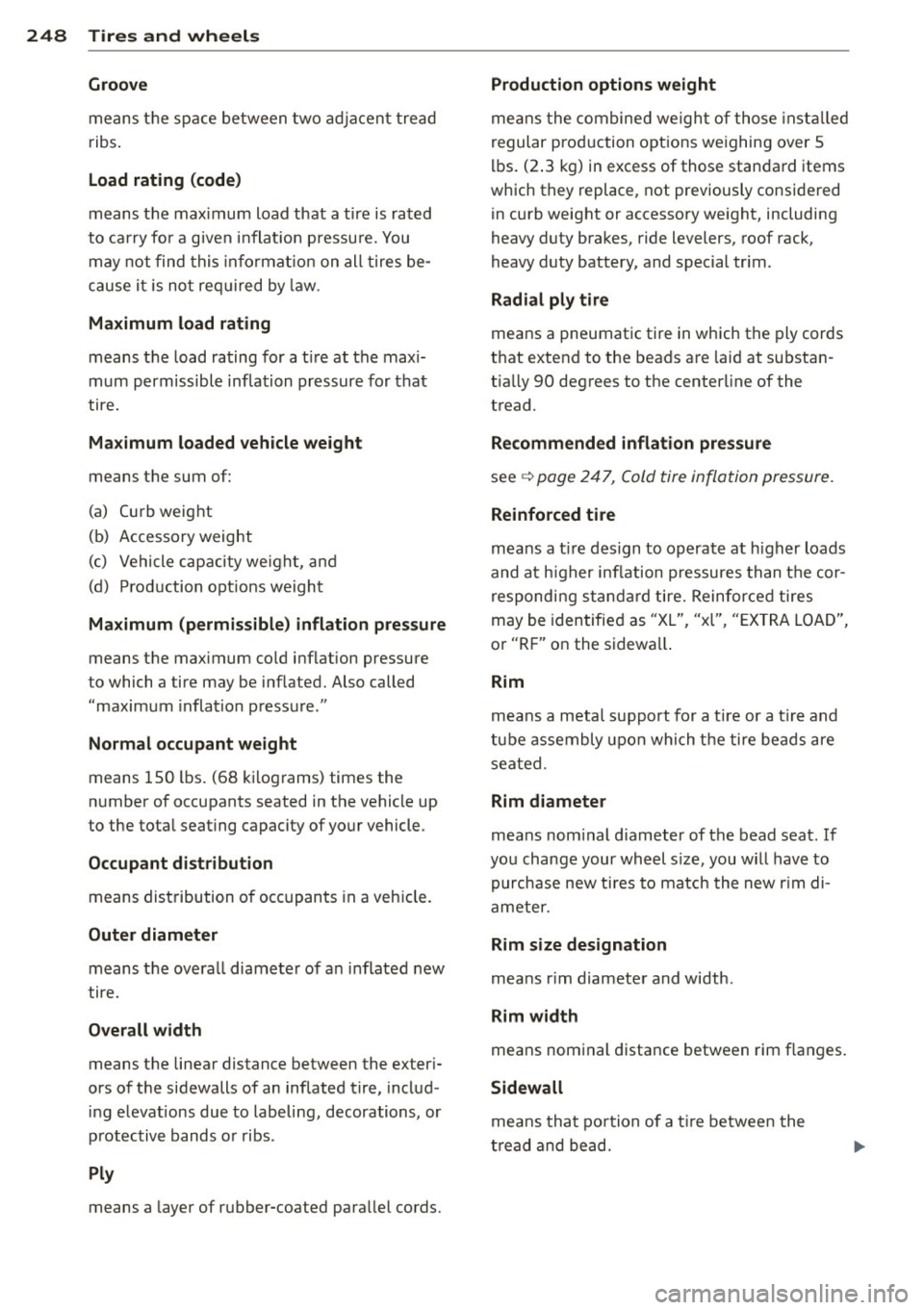
248 Tires and wheels
Groove
means the sp ace between two ad jacent tread
ribs .
Load rating (code )
means the maximum load that a tire is rated
to carry fo r a g iven inflat ion pressu re. You
may not find this in fo rmat io n on all t ires be
c a use i t is no t re quir ed by law.
Maximum load rating
means the load rating for a t ire at the max i
mum permissible inflation pressure for that
tire.
Maximum loaded vehicle weight
means t he sum of:
(a) Curb weig ht
(b) Accessory weight
( c ) Vehicle c apa city we ight, and
(d) Prod uction opt ions we ight
Maximum (permissible) inflation pressure
means t he maximum co ld inflation pressure
to which a tire may be inflated . Also called
"maxim um infla tion p ressure ."
Normal occupant weight
means 150 lbs. (68 k ilog rams) times the
n umber of occupants seated in the vehicle up
to the tota l seating capacity of yo ur vehicle .
Occupant distribution
means dist ribution o f occ upants in a veh icle.
Outer diameter
means t he overa ll diamete r of a n inflated new
tire.
Overall w idth
means the linea r distance between the exter i
ors of the sidewalls of an inflated tire, includ
ing e levations due to labeli ng, decorations, or
p rotectiv e bands o r ribs .
Ply
means a layer of rubber-coated para llel cords.
Production options weight
me ans the com bine d we igh t of tho se ins tall ed
regular prod uction opt ions we ighing over 5
lb s. (2 .3 kg) in excess of those stan da rd item s
which they replace, not previously considered
in curb weight or accessory we ight, including
heavy duty brakes, ride levelers , roof rack ,
heavy duty battery, and special tr im .
Radial ply tire
means a pneumat ic tire in wh ich the ply cords
t h at exte nd t o the beads are laid at substa n
t ia lly 90 deg rees to the center line of the
tread .
Recommended inflation pressure
see<=> page 247, Cold tire inflation pressure.
Reinforced tire
means a t ire des ign to operat e at h igher loads
and a t higher in flation pressures than t he cor
re spondi ng s tand ard tire. Reinfor ce d tires
may be iden tifie d as "X L" "xl" "E X TRA LOAD"
' ' '
or "RF " on the sidewa ll.
Rim
means a metal s upport for a ti re or a tire and
tube assembly upon whi ch t he tire beads are
sea ted.
Rim diameter
means nom inal d iameter of the bead seat. If
you change your wh eel s ize, you wi ll have to
purchase new ti res to match the new r im di
ameter.
Rim size designation
means r im diameter and width .
Rim width
means nominal d istance between rim fla nges .
Sidewall
means tha t po rtion of a tire betwee n the
t read and be ad.
Page 251 of 310
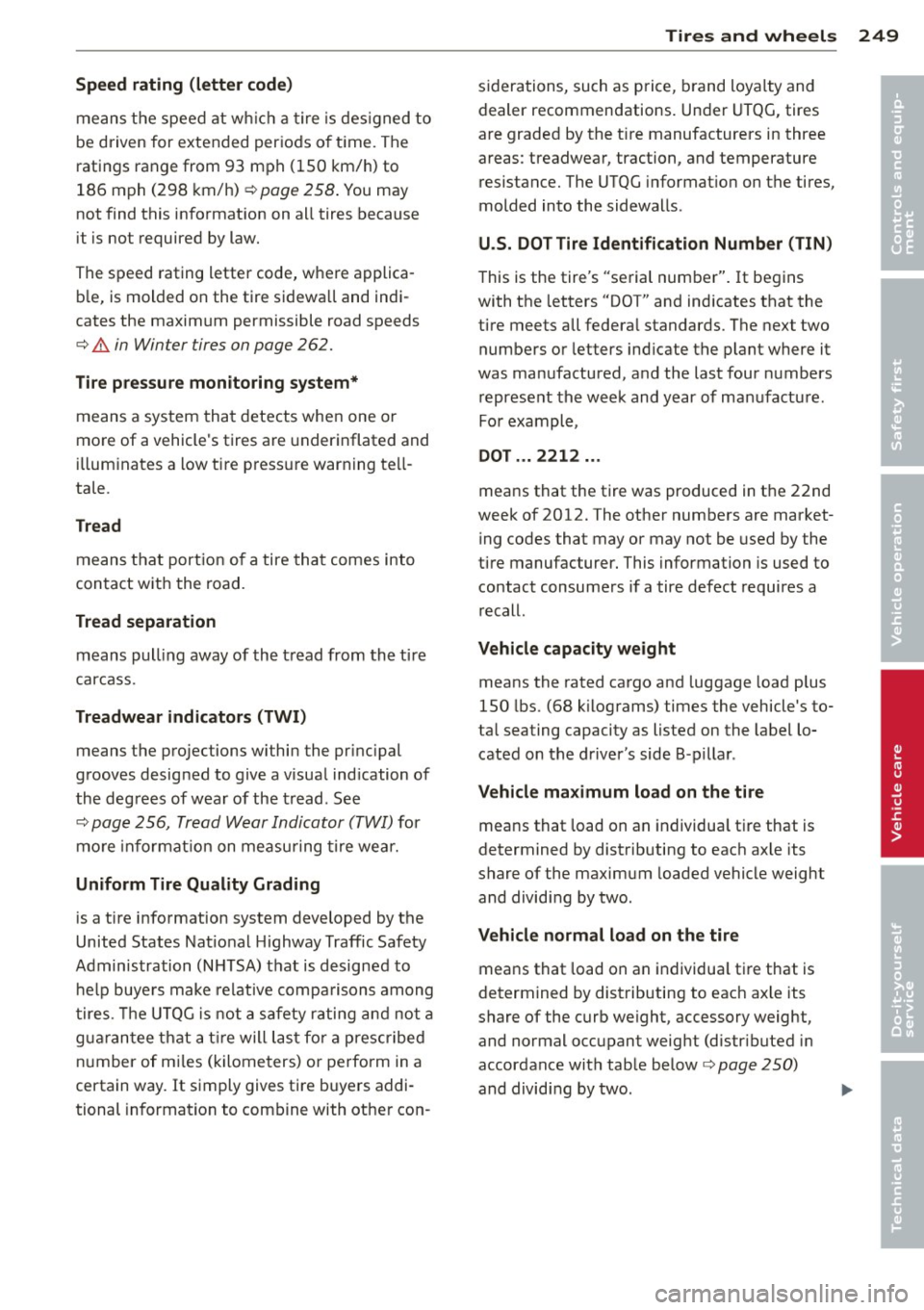
Speed rating (letter code)
means the speed at wh ich a tire is des igned to
be driven for extended periods of t ime . The
ratings range from 93 mph (150 km/h) to
186 mph (298 km/h)
¢page 258. You may
not find this information on all tires because
it is not required by law.
The speed rating letter code, where applica ble, is molded on the tire sidewall and indi
cates the maximum permissible road speeds
¢ &. in Winter tires on page 262.
Tire pressure monitoring system*
means a system that detects when one or
more of a vehicle's tires are underinflated and
illuminates a low tire pressure warn ing te ll
tale .
Tread
means that port ion of a tire that comes into
contact with the road.
Tread separation
means pulling away of the tread from the tire
carcass .
Treadwear indicators (TWI)
means the projections within the pr incipal
grooves designed to give a visual ind ication of
the degrees of wear of the tread. See
¢
page 256, Tread Wear Indicator (TWI) for
mo re inf ormat ion on measuring tire wear.
Uniform Tire Quality Grading
is a tire information system developed by the
United States National Highway Traffic Safety
Admin istration (N HTSA) that is designed to
help buyers make relative comparisons among
tires . Th e U TQG is not a safety rating and not a
g ua ran tee that a tir e will last for a prescribed
number of mi les (kilometers) or perform in a
certain way. It simply gives tire buyers addi
tional information to combine with other con-
Tires and wheels 249
siderations, such as price, brand loyalty and
dealer recommendations. Under UTQG, tires
are graded by the t ire manufacturers in three
areas : treadwear, traction, and temperature
resistance. The UTQG informat ion on the tires,
molded into the sidewalls .
U.S. DOT Tire Identification Number (TIN)
This is the tire's "serial number". It begins
with the letters "DOT" and indicates that the
tire meets all federa l standards. The next two
numbers or letters indicate the plant where it
was manufactured, and the last four numbers
represent the week and year of manufacture.
For example,
DOT ... 2212 ...
means that the tire was produced in the 22nd
week of 2012. The other numbers are market
ing codes that may or may not be used by the
tire manufacturer. This information is used to
contact consumers if a tire defect requires a
recall.
Vehicle capacity weight
means the rated cargo and luggage load plus
150 lbs. (68 k ilograms) times the vehicle's to
tal seating capacity as listed on the label lo
cated on the driver's side B -pillar .
Vehicle maximum load on the tire
means that load on an individual tire that is
determined by distributing to each axle its
share of the maximum loaded vehicle weight
and dividing by two.
Vehicle normal load on the tire
means that load on an individual tire that is
determined by distributing to each ax le its
share of the curb weight, accessory weight,
and normal occupant weight (distr ibuted in
accordance with table below¢
page 250)
and dividing by two.
•
•
Page 252 of 310

250 Tires and wheels
Occupant loading and distribution for vehicle normal load for various designated seating
capacities
Designated seating capacity,
number of occupants Vehicle normal load
, number Occupant distribution in a nor-
of occupants _____ mally loaded vehicle
4 2 _________ 2infro nt
5 3 2 in front, 1 in back seat
Cold tire inflation pressure
Tire pressure affects the overall handling, performance and safety of a vehicle.
Fi g. 196 Tire pressure label: located on drive r's si de 8 -
pilla r
Tire pressure gene ra lly refers to the amo unt
of air i n a tir e th at i t needs it to do its job and
s a fe ly c arry the combined load of the entire
ve hicl e and its contents . Tire pressure is
measured in kilopasca ls (kPa), the i nterna
tional measuring unit and in pounds per
squa re inc h (PSI). Tire pressure is based in
part o n the vehicle's design and load limit -
the greatest amount of we ight that the vehi
cle can car ry safely an d the t ire s ize. The prop
e r tire p ressu re is freq uen tly referred to as the
"recommende d cold tire inf lation pressure."
A ir in the tires exp ands when the ti re heats up
beca use of in ter nal fri ct ion when i t flexes in
use. The tire p ress ure is higher when the tire
has warmed up tha n when it is "cold." It is the
inflat ion pressure in a "cold" tire that counts.
Therefore, you sho uld never let air out of a
warm tire to match "cold ti re inflation pres
sure" recommendations. The t ires wo uld the n
be underinflated a nd could fail suddenly .
Maintaining proper t ire p ressure is one of the
most important things you can do to he lp
avoid sudden tire failure. Underinflated t ires
a re a majo r ca use of s udden tire failure. Keep
ing tires a t the r ight pressu re is also impor-
-~
-
( • (==. ~r: I := I :... 1)-~- -:-i
n. ........... ....,. .................... ,...,,.. ...... ...... .. '--............................................... ·-..
TN IIZE CO.O TN.,,.... ,.,._u OWlHSIONt ......,., DU ,.,._ua .-,--
-.....
--...........
- KP a PSI
- ICPA. a PSI
- ICPA. a PSI
Fig. 197 Tire p ressu re labe l
SEEOWHf:ft"S
MA. NUAl FOR
IHFOll:MA TION Va.t Lf M>.MJ!:L OU PltOPfllE f A.IN: ,ol.M"-.UtDf NNSCIOM.:MErtf5
tant for safe an d respo ns ive ve hicle ha ndling,
t raction, br aking and load ca rrying .
Tire pres
sures are particularly important when the
vehicle i s being dr iven at higher speeds, and
then especially when heavily loaded even
within the permissible load-carrying capaci
ties approved for your vehicle .
The recommende d tire pressures for your Audi
depen d on t he kind of tires o n your vehicle
and the number of passengers and/or amount
of luggage you w ill be transporti ng.
T he tire pressure label is located on the d riv
er's side B -pillar . The tire pressure labe l lists
the recommended cold t ire inflat ion pressures
fo r the vehicle at its maxim um capac ity
weight and tires t hat were on your veh icle at
t h e time it was ma nufactured.
If you wish to improve comfort when operat
ing the vehicle at normal load (up to 2 /3*
occupants ), you can adjust t ire pressures to
those specified for normal vehicle load. Be·
fore operating the vehicle at maximum load,
you mu st increase the tire pres sures to those
specified for maximum vehicle load
i:::> .&, . II>-
Page 253 of 310
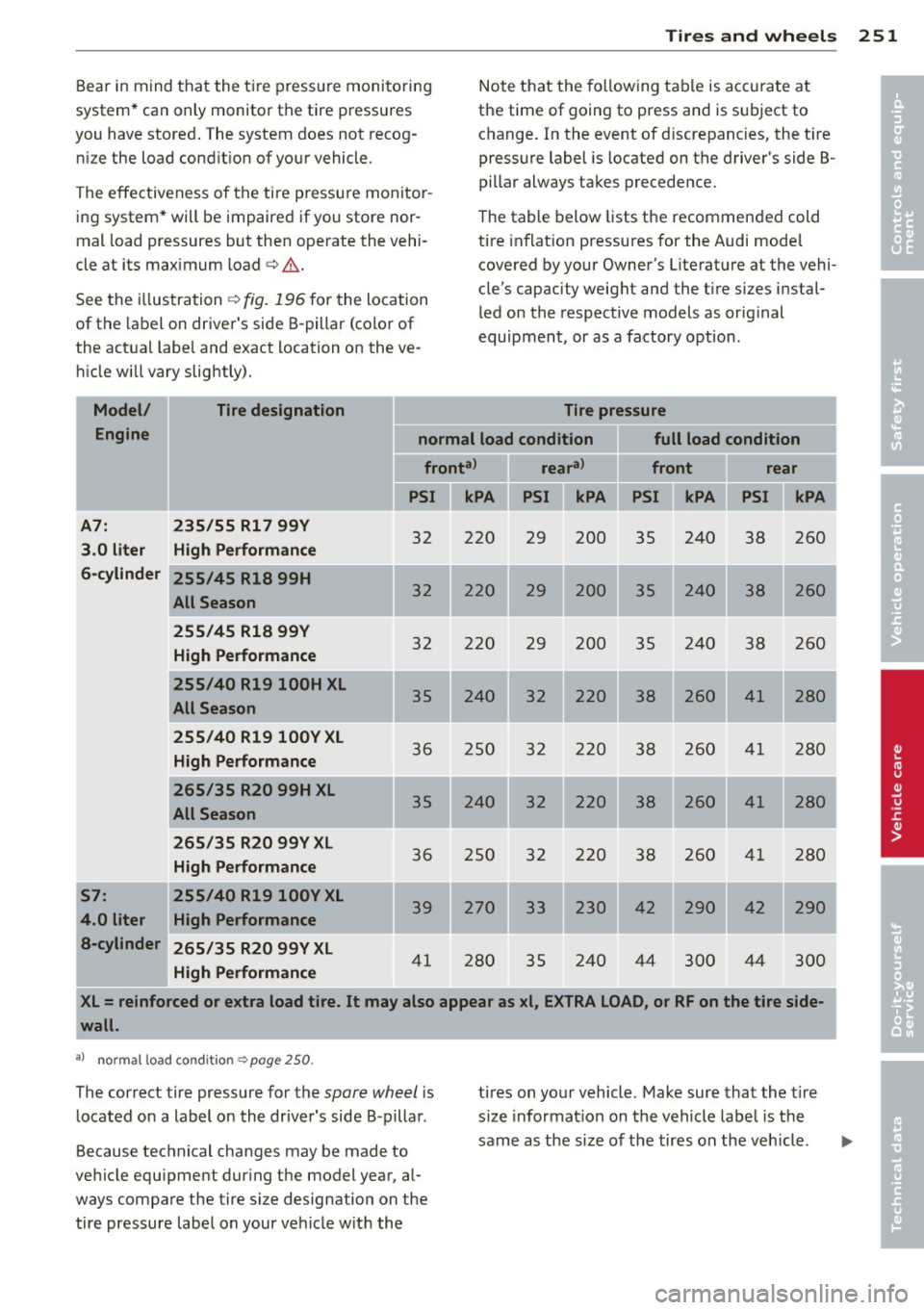
Tires and wheels 251
Bear in mind that the tire pressure monitoring
system* can only monitor the tire pressures
you have stored. The system does not recog
ni ze the load cond it ion of your vehicle.
The effectiveness of the tire pressure monitor
ing system* will be impaired if you store nor
mal load pressures but then operate the vehi
cle at its maximum load
c;, & .
See the illustration c;, fig. 196 for the location
of the label on driver's side B-pillar (co lor of
the actua l labe l and exact location on the ve
hicle will vary slightly).
Tire designation
Note that the following table is accurate at
the time of going to press and is subject to change. In the event of d iscrepancies, the t ire
pressure label is located on the driver's side B
pillar always takes precedence.
The table below lists the recommended cold
tire inflat ion pressures for the Audi mode l
covered by your Owner's Literature at the vehi
cle's capacity weight and the t ire sizes instal
led on the respective models as orig inal
equipment, or as a factory option.
Tire pressure
Model/
Engine normal load condition full load condition
fronta> reara>
front rear
PSI kPA PSI
A7: 235/55 Rl 7 99Y
3.0 liter High Performance
6-cylinder
S7:
4.0 liter a-cylinder 255/45 R18 99H
All Season
255/45 R18
99Y
High Performance
255/40 R19 l00H XL
All Season
255/40 R19100YXL
High Performance
265/35 R20 99H XL
All Season
265/35 R20 99Y XL
High Performance
255/40 R19
l00Y XL
High Performance
265/35 R20 99Y XL
High Performance
32 220
32 220
32 220
35 240
36 250
240
36 250
39 270
41 280 29 200
35 240 38 260
29 200 35 240 38 260
29 200 35 240 38 260
32 220 38 260 41 280
32 220 38 260 41 280
32 220 38 260 4
1
280
32 220 38 260 41 280
33 230
42 290
42 290
35 240
44 300 44
300
XL= reinforced or extra load tire. It may also appear as xl, EXTRA LOAD, or RF on the tire side-
wall.
al no rmal load condition c:;,page 250.
The correct tire pressure for the spare wheel is
located on a label on the driver's side B-pillar.
Because technical changes may be made to
vehicle equ ipment dur ing the model year, al
ways compare the tire size designation on the
tire pressure label on your vehicle w ith the tires on your vehicle.
Make sure that the tir e
s ize informat ion on the vehicle label is the
same as the size of the tires on the vehicle .
'
I
'
I
•
•